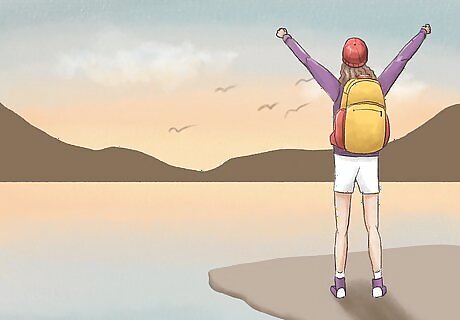
views
Locating Your Muse through Creative Pursuits

Listen to music. Songs, and music in general, can be great ways to find your muse. The lyrics and the melodies that you listen to can help lighten thoughts that might weigh you down. Music, specifically lyrics, can also transport you to a specific time or place and provide you with ideas to help spark your own creativity. This is one of the more classic pieces of advice for finding your muse, and it works well for many people. Music often tells stories that can be inspiring to some people. There are many aspects of music that can spark creativity. For example, you might draw inspiration from the lyrics, the tone of the song or piece, or just the feelings that the music evokes in you.

Write whatever comes to mind to get your creativity flowing. You may not have any concrete ideas, but simply writing something down can help generate creative thoughts. Consider it a form of brainstorming. Remember that you can always start over or revise previous thoughts before you finish a final draft. Writing, in and of itself, can help you generate thoughts. Try free writing or journaling for 15 minutes every day. It is best if you do this type of writing by hand, because it will connect you more fully to the writing process. EXPERT TIP Julia Martins Julia Martins BA in English, Stanford University Julia Martins is an aspiring writer currently living in San Francisco, California. She graduated from Stanford University with a BA in English and has been published in Cornell University's Rainy Day Magazine, Stanford University's Leland Quarterly, and Bards and Sages Quarterly. Julia Martins Julia Martins BA in English, Stanford University Julia Martins, creative writer, tells us: "One of my favorite writing exercises is to write as many story ideas or character traits as I can think of in 5 minutes. A lot of them are really bad, but because I'm writing whatever comes to mind – without filtering my ideas – I often find a few great ones sneak through!"

Read a lot of different stories to find creative inspiration. Even if you stick to one genre when you write, you can borrow smaller concepts, personality quirks, scenery ideas, and so much more from reading different types of books. Each story was probably inspired from the author's own exploration of other books or tales and things that happened to or around them in their daily lives. Try re-reading a favorite story or a new book that you may enjoy. Reading the work of other writers can help you find and refine your own creative voice. Read as much and as often as possible.

Try doodling or drawing to relax and stimulate your creativity. You can express yourself artistically without producing a professional drawing or piece of artwork every time. Instead, try spontaneous activities, such as doodling or sketching, as a way to be creative without the pressure that can come with creating finished art. If you are not comfortable drawing but still want to express your creativity, you could try coloring. People find inspiration in all sorts of creative activities. Have fun and get in touch with your artistic side without worrying about producing something perfect.
Finding Inspiration in Your Environment

Explore the world around you to find new ideas. This is something that is often overlooked, simply because we go to and from the same places every day. Try and pay closer attention to common places in your life, such as home, work, the grocery store, or a local park. Spend more time thinking about and watching your local environment in order to find something that inspires you. Try out these fun ways to make your daily routine more engaging and inspiring: Walk around your house and try to find 5 to 10 items that you forgot about. Re-engage with them and remember the story of how they came to be in your possession. Take a new route to work. If you normally drive or take public transit, try riding a bike or walking. While on public transit, don’t spend the entire time listening to music or reading the paper. Instead, try listening to the conversations of the people around you. These stories may help to promote new and creative thoughts. EXPERT TIP Don't worry about looking for a "traditional" muse – your "muse" can be a painting, a quote, an emotion, or anything else that inspires you! Julia Martins Julia Martins BA in English, Stanford University Julia Martins is an aspiring writer currently living in San Francisco, California. She graduated from Stanford University with a BA in English and has been published in Cornell University's Rainy Day Magazine, Stanford University's Leland Quarterly, and Bards and Sages Quarterly. Julia Martins Julia MartinsBA in English, Stanford University

Change your creative environment. If you normally do your creative work from an office or studio, try changing your environment to help inspire you in a variety of ways. You may find inspiration from the scenery, scents, and sounds that surround you in an unfamiliar space. For example, instead of writing at home, work in a coffee shop or library to mix up the scenery. Alternatively, if you typically work inside, try relocating to an outdoor environment, like a park or garden.

Engage with nature to get inspired and spark your imagination. Walking through nature and observing animals, plants, stars, and clouds has been a source of inspiration for many artists throughout history. Spend some time outdoors each day learning how plants and animals live. It is easy to find inspiration in the natural beauty of the world. You can also try travelling to different parts of the world to experience unique landscapes. If you are an artist, bring your supplies with you out into nature and try and capture the landscape. Similarly, if you are a writer, bring a notebook and write down some of the feelings and words that come to mind while you are consumed by the natural world. You can also take photographs of images that you find interesting or inspiring, like a huge old tree or a dew-covered spiderweb. That way, you can return to the image later, when you are ready to do some creative work and need some ideas.

Go for a walk to overcome creative blocks. Sometimes people have creative blocks because they are struggling to find new ideas. If this happens to you, get up and go for a walk. Let yourself relax and allow your mind to wander as you move. You are more likely to have an epiphany while you are away from your workspace and actively walking around. Studies show that the act of walking can improve your creative thinking process, and that those creativity boosting benefits last even for a short while after you sit back down. When it comes to stirring the creative juices, the act of walking matters more than the environment itself. Even walking on a treadmill while facing a blank wall can help jumpstart your creativity!
Connecting with People to Find Your Muse

Socialize with people to get new ideas and perspectives. A great way to find a muse or inspiration is by socializing with a variety of people. Surround yourself with several personality types in your daily life and observe how each of them respond to both normal and unique situations. These observations can help to inspire creative stories. For example, think of a time when your friend did something that was hilarious or interesting. Can you find inspiration in these stories? You may find inspiration in stories about people overcoming adversity. You could also find inspiration in stories of hardship and loss.

Seek out other creative people who share your passion. Often people will find a muse in other creative people who inspire them by creating art. For example, if you are a musician, you may get inspired by other musicians who are creating new and unique sounds and music. Ask them where they get their artistic inspiration and how they create art on a daily basis. Collaborating with other artists, writers, or musicians can also help to inspire you. Sometimes your muse is a person with similar interests to yourself. Family and friends can also provide you with inspiration when they achieve success.

People watch in public spaces to hone your observational skills. Sometimes you will find a muse in a complete stranger. Make sure that you are mentally present when you are out in public. For example, avoid spending too much time on your phone. Instead, look around and watch other people as they go about their daily lives. What motivates them? How do their lives differ from yours? Sit on a park bench and watch people interact. Go to an airport or subway station and watch people as they come and go.

Talk to older people to expand your horizons. People who have lived longer than you will have a wealth of experience that you can learn and draw inspiration from. Talk to older friends, acquaintances, and relatives so that you can hear their stories and broaden your understanding beyond your own thoughts and experiences. For example, you might ask your grandmother to tell a story about something significant that happened in her life before you were born. You may also find it helpful to talk to people who have different social and cultural backgrounds from your own.




















Comments
0 comment